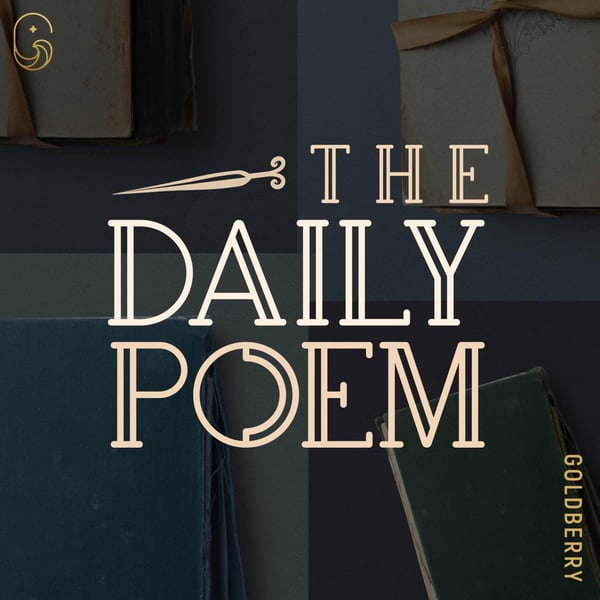Wendy Cope's "Emily Dickinson"
The Daily Poem
Goldberry Studios
4.6 • 729 Ratings
🗓️ 24 September 2024
⏱️ 5 minutes
🧾️ Download transcript
Summary
Today’s poem, from the delightfully clever Wendy Cope, epitomizes the rare and complicated light verse form: the double-dactyl.
Wendy Cope was raised in Kent, England, where her parents often recited poetry to her. She earned a BA in history and trained as a teacher at Oxford University. Cope taught in primary schools for many years before publishing her first book of poetry, Making Cocoa for Kingsley Amis (1986). The collection was an incredible success, selling tens of thousands of copies in the UK. It also announced Cope’s remarkable talents for parody, word play, dexterity with received forms, and the use of humor to address grave topics. In the Los Angeles Review of Books, critic and poet A.M. Juster declared, “one has to go back to Byron to find a poet as consistently witty, wide-ranging, and technically outstanding as Cope.”
Cope’s poetry collections include Serious Concerns (1992); If I Don’t Know (2001), shortlisted for the Whitbread Poetry Award; Two Cures for Love: Selected Poems 1979–2006 (2008); Family Values (2011); Christmas Poems (2017), a collection of new and previously published Christmas-themed work; and Anecdotal Evidence (2018). She is the author of the prose collection Life, Love and the Archers (2015) and two books for children, Twiddling Your Thumbs (1988) and The River Girl (1991), and the editor of numerous anthologies, including, The Faber Book of Bedtime Stories (1999).
Cope has received a Cholmondeley Award and a Michael Braude Award for Light Verse from the American Academy of Arts and Letters. In 2010, she was awarded an Order of the British Empire. She is a Fellow of the Royal Society of Literature and lives in Winchester, England.
-bio via Poetry Foundation
This is a public episode. If you'd like to discuss this with other subscribers or get access to bonus episodes, visit dailypoempod.substack.com/subscribe
Transcript
Click on a timestamp to play from that location
| 0:00.0 | Welcome back to The Daily Poem, a podcast from Goldberry Studios. |
| 0:04.6 | I'm Sean Johnson, and today is Tuesday, September 24th, 2024. |
| 0:10.0 | Today's poem is by Wendy Cope, and it's called Emily Dickinson. |
| 0:13.9 | And it is a particular form of verse known as the double dactyl. |
| 0:20.0 | The double dactyl is an uncommon form of light verse |
| 0:26.2 | created in the 20th century by poets Anthony Hecht and Paul Pascal |
| 0:32.1 | in or near the year 1961. |
| 0:37.2 | And it's uncommon to encounter many classic double dactyls for that reason. |
| 0:43.6 | They're not that old, but also because it's a tricky form, and there aren't too many good ones. |
| 0:50.5 | The form demands that each double dactyl poem be two stanzas long, each stanza comprised of four lines. |
| 0:58.9 | Three of those lines being written in dactylic diameter, which if you'll recall from your school days, or if you won't, is two dactylic feet, a dactyl being a sequence of one stressed and then two |
| 1:14.5 | unstressed syllables. For a sum total of six syllables in a line, stressed, unstressed, unstressed, |
| 1:22.7 | unstressed, stressed, unstressed. Then the fourth line in each stanza is to be a single coriam or one metric foot that contains a stressed syllable, two unstressed syllables, and then another stressed syllable. |
| 1:41.3 | And as if that weren't enough, there are a few more rules. |
| 1:47.3 | The first line of first stanza is supposed to be some kind of repetitive nonsense word. |
| 1:54.5 | The second line of the first stanza is supposed to be a proper noun and the subject of the poem. |
| 2:02.3 | And then the final oddball rule is that at least one line in the second stanza |
| 2:09.0 | is supposed to be, some people allow leeway on this one because it's the hardest requirement, |
| 2:16.2 | but is supposed to be a single double-dactylic word |
| 2:21.0 | that is a single word that is six syllables long and fits the pattern of a double-dactyl. |
| 2:29.1 | Stress, unstress, unstress, stress, unstress, stress, unstress. |
| 2:32.8 | Now, you've probably gotten confused even listening to the description of the double |
... |
Please login to see the full transcript.
Disclaimer: The podcast and artwork embedded on this page are from Goldberry Studios, and are the property of its owner and not affiliated with or endorsed by Tapesearch.
Generated transcripts are the property of Goldberry Studios and are distributed freely under the Fair Use doctrine. Transcripts generated by Tapesearch are not guaranteed to be accurate.
Copyright © Tapesearch 2025.

